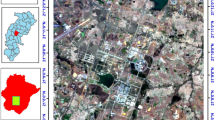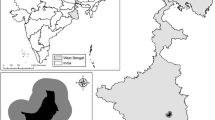Abstract
The goal of this study was to investigate land use changes in urban and peri-urban Hyderabad and their influence on wastewater irrigated rice using Landsat ETM + data and spectral matching techniques. The main source of irrigation water is the Musi River, which collects a large volume of wastewater and stormwater while running through the city. From 1989 to 2002, the wastewater irrigated area along the Musi River increased from 5,213 to 8,939 ha with concurrent expansion of the city boundaries from 22,690 to 42,813 ha and also decreased barren lands and range lands from 86,899 to 66,616 ha. Opportunistic shifts in land use, especially related to wastewater irrigated agriculture, were seen as a response to the demand for fresh vegetables and easy access to markets, exploited mainly by migrant populations. While wastewater irrigated agriculture contributes to income security of marginal groups, it also supplements the food basket of many city dwellers. Landsat ETM + data and advanced methods such as spectral matching techniques are ideal for quantifying urban expansion and associated land use changes, and are useful for urban planners and decision makers alike.







Similar content being viewed by others
References
Biggs TW, Thenkabail PS, Gumma MK, Scott CA, Parthasaradhi GR, Turral HN (2006) Irrigated area mapping in heterogeneous landscapes with MODIS time series, ground truth and census data, Krishna Basin, india. Int J Remote Sens 27:4245–4266
Congalton RG, Green K (1999) Assessing the accuracy of remotely sensed data: principles and practices. Lewis, New York
Defries RS, Hansen MC, Townshend JRG (2000) Global continuous fields of vegetation characteristics: a linear mixture model applied to multi-year 8 km AVHRR data. Int J Remote Sens 21:1389–1414
Ensink JHJ, Mahmood T, Dalsgaard A (2007) Wastewater-irrigated vegetables: market handling versus irrigation water quality. Trop Med Int Health 12:2–7
ERDAS (2007) ERDAS Field Guide, Volume 1, October 2007.
Gopal S, Woodcock C (1994) Theory and methods for accuracy assessment of thematic maps using fuzzy sets. Photogramm Eng Remote Sens 60:181–188
Gumma M, Thenkabail P, Fujii H, Namara R (2009) Spatial models for selecting the most suitable areas of rice cultivation in the Inland Valley Wetlands of Ghana using remote sensing and geographic information systems. J Appl Remote Sens 3:033537
Gumma MK, Nelson A, Thenkabail PS, Singh AN (2011a) Mapping rice areas of South Asia using MODIS multitemporal data. J Appl Remote Sens 5:053547
Gumma MK, Thenkabail PS, Muralikrishna IV, Velpuri MN, Gangadhararao PT, Dheeravath V, Biradar CM, Acharya Nalan S, Gaur A (2011b) Changes in agricultural cropland areas between a water-surplus year and a water-deficit year impacting food security, determined using MODIS 250 m time-series data and spectral matching techniques, in the Krishna River basin (India). Int J Remote Sens 32:3495–3520
Markham BL, Barker JL (1986) Landsat MSS and TM post-calibration dynamic ranges, exoatmospheric reflectances and at-satellite temperatures. Earth Observation Satellite Company, Lanham, Maryland, Landsat Technical Notes, 1, August.
Neckel H, Labs D (1984) The solar radiation between 3300 and 12500 A. Sol Phys 90:205–258
Peuquet D, Marble D (1990) Introductory readings in geographic information systems. Taylor and Francis, New York, p 381
Thenkabail PS, Enclona EA, Ashton MS, Legg C, De Dieu MJ (2004) Hyperion, IKONOS, ALI, and ETM + sensors in the study of African rainforests. Remote Sens Environ 90:23–43
Thenkabail PS, Schull M, Turral H (2005) Ganges and Indus river basin land use/land cover (LULC) and irrigated area mapping using continuous streams of MODIS data. Remote Sens Environ 95:317–341
Tomlinson R (2003) Thinking about geographic information systems planning for managers. ESRI Press. 283 p.
Tucker C, Grant D, Dykstra J (2005) NASA’s global orthorectified Landsat data set. Photogram Eng Remote Sensing 70:313–322
Van Rooijen DJ, Turral H, Wade Biggs T (2005) Sponge city: water balance of mega-city water use and wastewater use in Hyderabad, India. Irrig Drain 54:S81–S91
Van Rooijen DJ, Turral H, Biggs TW (2009) Urban and industrial water use in the Krishna Basin, India. Irrig Drain 58:406–428
Velpuri NM, Thenkabail PS, Gumma MK, Biradar CB, Noojipady P, Dheeravath V, Yuanjie L (2009) Influence of resolution in irrigated area mapping and area estimations. Photogramm Eng Remote Sens 75:1383–1395
Acknowledgements
The authors would like thank to Dr. Bill Hardy, Science Editor/Publisher, IRRI, for editing. The Landsat ETM + data were provided through the Earth Observing System Data and Information System (EOSDIS), so we would like to thank them for this wonderful service.
Author information
Authors and Affiliations
Corresponding author
Rights and permissions
About this article
Cite this article
Gumma, K.M., Van Rooijen, D., Nelson, A. et al. Expansion of urban area and wastewater irrigated rice area in Hyderabad, India. Irrig Drainage Syst 25, 135–149 (2011). https://doi.org/10.1007/s10795-011-9117-y
Published:
Issue Date:
DOI: https://doi.org/10.1007/s10795-011-9117-y




